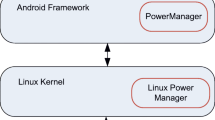Abstract
Recently, the number of mobile users grow enormously. Even though hardware technologies have been taken to many advantages, which aim at increasing the battery capacity, people are still facing with the problem of battery shortage. An application that runs functionally correct and has a friendly graphic user interfaces still causes users frustrated if it drains the battery. In parallel with increasing the energy storage capability of mobile device, optimizing the source code to reduce power consumption is an emerging topic. This paper presents a new approach to modeling and evaluating power consumption of mobile applications. First, we introduce new definitions of power states and a power consumption automaton (PCA) for a hardware component. In the next step, we propose algorithms to optimize and merge these into an unified automaton. In order to estimate the power consumption amount, the power automaton is refined with time aspect and power coefficients. Finally, we develop a support tool, which is a plug-in for Android studio and IntelliJ for visualizing the power machines and estimating the accumulated power consumption of an application use-case.











Similar content being viewed by others
References
Android api. https://developer.android.com/guide/index.html
Javaparser. https://github.com/javaparser/javaparser
Mediaplayer class. https://developer.android.com/reference/android/media/MediaPlayer.html
Ali-Gombe A, Irfan A, Golden RG III, Vassil R (2016) AspectDroid: android App analysis system. In: Proceedings of the sixth ACM on conference on data and application security and privacy, pp 145–147
Carroll A, Heiser G et al (2010) An analysis of power consumption in a smartphone. In: USENIX annual technical conference, vol 14, Boston, MA, pp 21–21
Couto M, Carcao T, Cunha J, Fernandes JP, Saraiva J (2014) Detecting anomalous energy consumption in android applications lecture notes in computer science (including subseries lecture notes in artificial intelligence and lecture notes in Bioinformatics), 8771 LNCS
Datta SK, Bonnet C, Nikaein N (2012) Android power management: current and future trends. In: 2012 First IEEE workshop on enabling technologies for smartphone and internet of things (ETSIoT). IEEE, pp 48–53
Grzes TN, Solov’ev VV (2015) Minimization of power consumption of finite state machines by splitting their internal states. J Comput Syst Sci Int 54(3):367–374
Hopcroft JE, Motwani R, Ullman JD (2006) Introduction to automata theory, languages, and computation, 3rd. Addison-Wesley, Boston
Kim KH, Min AW, Gupta D, Mohapatra P, Pal Singh J (2011) Improving energy efficiency of wi-fi sensing on smartphones. In: 2011 Proceedings IEEE INFOCOM, pp 2930–2938
Li D, Hao S, Halfond WGJ, Govindan R (2013) Calculating source line level energy information for Android applications. In: Proceedings of the 2013 international symposium on software testing and analysis - ISSTA 2013, p 78
Mendonça J, Lima R, Andrade E, Callou G (2015) Assessing performance and energy consumption in mobile applications. In: 2015 IEEE international conference on systems, man, and cybernetics (SMC). IEEE, pp 74–79
Murmuria R, Medsger J, Stavrou A, Voas JM (2012) Mobile application and device power usage measurements. In: Proceedings of the 2012 IEEE 6th international conference on software security and reliability SERE 2012, pp 147–156
Nakajima S (2013) Model-based Power Consumption Analysis of Smartphone Applications ACESMB@ MoDELS
Pathak A, Hu CY, Zhang M (2012) Where is the energy spent inside my app?: fine grained energy accounting on smartphones with eprof. In: Proceedings of the 7th ACM European conference on computer systems, EuroSys ’12, New York, NY, USA. ACM
Zhang L, Dick RP, Mao MZ, Wang Z, Arbor A (2010) Accurate online power estimation and automatic battery behavior based power model generation for smartphones. In: 2010 IEEE/ACM/IFIP international conference on hardware/software codesign and system synthesis (CODES+ISSS), Scottsdale, AZ, pp 105–114
Zhuang Z, Kim K-H, Singh JP (2010) Improving energy efficiency of location sensing on smartphones. In: Proceedings of the 8th international conference on mobile systems, applications, and services, MobiSys ’10, New York, NY, USA. ACM, pp 315–330
Acknowledgments
This work is partly supported by the project no. 102.03–2014.40 granted by Vietnam National Foundation for Science and Technology Development (Nafosted).
Author information
Authors and Affiliations
Corresponding author
Rights and permissions
About this article
Cite this article
Le, H.A., Bui, A.T. & Truong, NT. An Approach to Modeling and Estimating Power Consumption of Mobile Applications. Mobile Netw Appl 24, 124–133 (2019). https://doi.org/10.1007/s11036-018-1138-4
Published:
Issue Date:
DOI: https://doi.org/10.1007/s11036-018-1138-4




